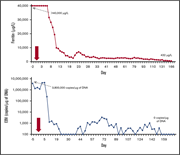Issue Archive
Table of Contents
DRUG ADVANCES
Inotuzumab: from preclinical development to success in B-cell acute lymphoblastic leukemia
Clinical Trials & Observations
The CD22-targeting monoclonal antibody inotuzumab ozogamicin was recently approved for the treatment of relapsed/refractory B-cell acute lymphoblastic leukemia. In a Drug Advances article, Wynne and colleagues describe in detail the development and application of this novel therapeutic.
EXCEPTIONAL CASE REPORT
CLINICAL TRIALS AND OBSERVATIONS
Burden and impact of multifactorial geriatric syndromes in allogeneic hematopoietic cell transplantation for older adults
Clinical Trials & Observations
HEMATOPOIESIS AND STEM CELLS
microRNA-22 promotes megakaryocyte differentiation through repression of its target, GFI1
The role of microRNAs in a number of tissue differentiation processes including hematopoiesis is an area of active investigation with biological and clinical amplifications. Weiss and Ito explore the impact of microRNA-22 in megakaryocytic differentiation, demonstrating a major role for this microRNA.
Fluorescent labeling of CRISPR/Cas9 RNP for gene knockout in HSPCs and iPSCs reveals an essential role for GADD45b in stress response
Gene editing of hematopoietic stem cells with CRISPR/Cas9-gRNA holds great promise to develop new treatment options for some of the most vexing genetic disorders. However, there are many technical limitations to be overcome. Nasri and colleagues describe a novel method that is validated by editing out a gene involved in DNA repair.
IMMUNOBIOLOGY AND IMMUNOTHERAPY
LYMPHOID NEOPLASIA
Identification of recurrent noncoding mutations in B-cell lymphoma using capture Hi-C
The search for driver mutations is critical to the understanding of many malignancies and has yielded important targets for therapeutic intervention. To date, most of these studies have focused on coding regions of the genome. Cornish and colleagues explore the potential role of noncoding regions of the genome in a large cohort of lymphoma patients.
PLATELETS AND THROMBOPOIESIS
TRANSPLANTATION
MIPSS70+ v2.0 predicts long-term survival in myelofibrosis after allogeneic HCT with the Flu/Mel conditioning regimen
Clinical Trials & Observations
Patients with myelofibrosis present a challenging clinical dilemma. The only curative therapy is allogeneic hematopoietic cell transplantation. Still, because of the variability in clinical course, comorbid medical conditions, and disease status, the decision to proceed is often difficult. Snyder and colleagues analyze a large cohort of patients with myelofibrosis receiving a common preparative regimen. The cohort presents patient and disease characteristics that predict outcomes. Their findings may allow for more accurate assessments of risk and benefit.
-
Cover Image
Cover Image
![issue cover]()
COVER FIGURE
Linking of cis-regulatory elements (CREs) to gene expression to identify recurrent mutated noncoding regulatory regions in B-cell lymphoma. See the article by Cornish et al. - PDF Icon Front MatterFront Matter
- PDF Icon Editorial BoardEditorial Board
Advertisement intended for health care professionals
Advertisement intended for health care professionals











